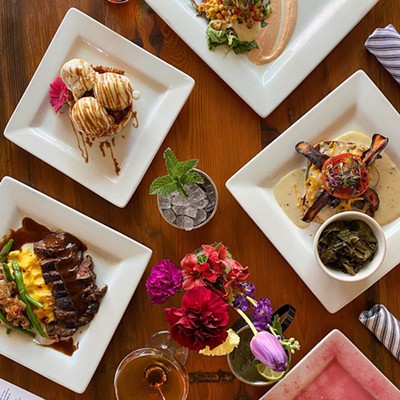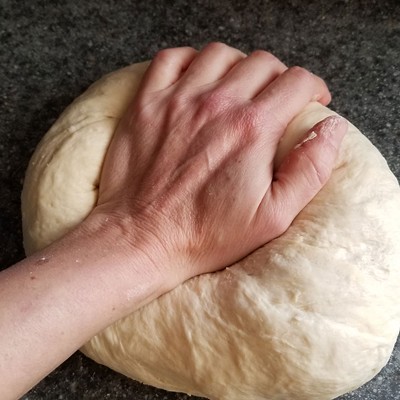“This, I thought, was eating,” Bourdain wrote, describing the onglet, better known as hanger steak.
When a cow is processed, there is this mysterious, little-known piece of meat, which some people (including me) find good. Others, however, stay far away.
There is nothing modern about the no-waste hanger steak; it’s been a cut known for centuries. In meat market lingo, it was called “butcher steak” because beef processors were known to get first dibs on this piece of meat.
A hanger steak is so-called because it “hangs” from the diaphragm. There is only one cut per animal, and the meat is bisected by a tough membrane. Hanger steaks are known to be more flavorful than the other cut from the diaphragm, called the skirt steak, but is not particularly tender.
At La Boucherie attached to La Baguette Bistro & Bakery, 7408 N. May, meat cutter David Robin sells hanger steaks. Robin has more than 17 years experience as a meat cutter and said he sells the steak to people who like the taste and texture of the piece and want to cook it themselves. For those who don’t feel like tying on an apron, hanger steak is available on the menu at La Baguette.
“It’s off the beaten track, but it’s delicious,” Robin said. “The hanging tender is a soft-grained, textured, elliptical-shaped muscle that is attached to the diaphragm and the juncture of the lumbar/thoracic vertebrae. (There is) only one per carcass.”
Robin said his passionate foodies who purchase hanger steaks are the ones who know and understand more unusual cuts, such as tri-tip and flat iron.
“Hanger steak is somewhat out of the norm, but they can come in and get anything here,” Robin said, with Chef Alain Buthion in agreement.
“Everything we have in the butcher shop next door can be done in the kitchen, and we do hanger steaks all of the time,” said Buthion, executive chef and co-owner of La Baguette with his brother, Michel.
But although hanger steak is on the menu at La Baguette, it is harder to find at other steak houses and butcher shops.
At Mahogany Prime Steakhouse, 3241 W. Memorial, manager Daron Southerland said the establishment does not handle hanger steaks, instead concentrating on Prime steaks, 8- and 12-ounce filets and New York strip steaks. Neither does Bill Kamp’s Meat Market, 7310 N. Western, or Cattlemen’s Steakhouse, 1309 S. Agnew.
It is possible to order hanger steak at Deep Fork Grill, 5418 N. Western, although it is not on its menu.
“If people would love to have it that evening, we would prefer that they call ahead due to the fact that we have a tendency to sell out,” said manager Allison Dake. The chefs at Deep Fork have served the beef with golden brown gratin or whipped potatoes and asparagus and often will serve it with a béarnaise sauce and steak frites.
Jessee Davis, manager at Country Home Meat Co., 2775 E. Waterloo Road in Edmond, said they sell hanger steaks at $2.49 per pound.
“We have a butcher shop and sell quite a bit of retail,” Davis said.
Davis said most of the shoppers buying hanger steaks at Country Home use the cut of meat in stews or soups.
Although hanger steak is a little better known today than it has been in the past, it’s still not common. I’ve looked through scores of cookbooks to no avail, including some meat cookbooks, where it doesn’t even get a mention.
However, in “Cutting Up in the Kitchen: The Butcher’s Guide to Saving Money on Meat and Poultry,” the late Merle Ellis wrote that juicy hanger steak was one of the butcher’s best-kept secrets.
“Nobody seems to know just what the thing is,” Ellis wrote. “It’s just there.”
TIMING IS EVERYTHING
Thinking of grilling that hanger steak? Here are some
tips. Light the fire on your grill at least 45 minutes before cooking.
That will give the fire a chance to burn down and leave glowing coals
that will be covered in ash. Your best bet is hardwood charcoal, which
burns hot and clean, but charcoal briquettes will suffice.
When
grilling steaks, be sure to take the meat out of the refrigerator at
least half an hour before cooking. Remove the grill rack and oil it with
a nonstick vegetable spray. Set the rack about 4 to 5 inches above the
fire for thin cuts of steak. If you are doing a thicker steak, set the
rack 6 to 7 inches above the heat, so it doesn’t char before the
interior is ready.
When is the steak done? In
beef steaks, the meat is on the rare side when the interior of the steak
is very red and just slightly warm. It is medium rare when its interior
is red and fully warm. For those who like it medium, look for the
inside of the steak to be hot and red with some pink surrounding it. For
medium-well, the interior of the steak is pink and hot. And for those
who can bear well done, the interior of the steak is grayish-brown and
fully hot. —Carol Smaglinski











